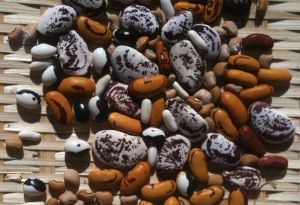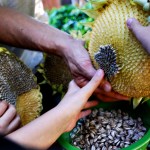Why do I care about seeds?
 A fascination with little tiny objects – that’s probably how it started.
A fascination with little tiny objects – that’s probably how it started.
I remember collecting seeds in my mother’s garden as a child. I’d gather minuscule flat honey-tan alyssum seeds. In my pocket linings I’d hoard round red-brown glossy seeds from a special heirloom flower.
Vegetables came from seeds in those days. If nursery 6-packs existed, I didn’t know about them. The next-door neighbor would gift an occasional veggie start, but for the most part we sprouted everything ourselves.
When I returned to vegetable gardening as an adult I naturally turned to seeds. Within the first year or so I discovered heirloom vegetable catalogs. Over my morning cup of tea I’d pour through the descriptions. My endless plant lists wove fantasy gardens.
Reality was a small patch that grew more weeds than vegetables. As I learned a bit about soil-building, my results steadily improved.
My sister and I began purchasing seed from catalogs together. The job of splitting packets between our families often fell to me. I’d send her half out in the original packaging, leaving me with a collection of odd lumpy envelopes with partial descriptions. I became adept at recognizing differences between major plant families. The blackened angular ones were onion family. Dark brown and ball-bearing round were some kind of kale or broccoli. Spiky pale-tan balls were chard.
In addition to the seeds, I devoured the books listed at the back of the garden catalogs. I learned the deep issues within the structure of our food supply: soil depletion, increasing water scarcity, corporate control, loss of diversity, and (of course) climate change. Home gardens and seedsaving were part of the solutions.
Meanwhile I had a busy life with small children. Our Southern California winter rains produced easy and abundant cool season gardens. I’d get collards as high as my waist, amid a carpet of cilantro and arugula.
Too often the garden would get ahead of me. Plants bolted to flower and seed before I could clear them out. Dropped seeds would linger and lie dormant for a season. With the next year’s cool rains they’d burst forth in a spontaneous garden full of lusty and vigorous volunteers. They came up everywhere, even in the so-called pathways. My now-grown son and daughter fondly remember the year the arugula grew so tall that we “lost” our collie-sized dog in it.
Each spring I’d dig up some of the volunteer collards and chard seedlings to share with my sister. The ones that had sprouted in the most inconvenient places were the first to go. We’d laugh how her refined gourmet garden began as weeds from my “lawn.”
After a few years of seedling sharing my sister wanted to start her garden earlier. She began asking for seed. I had plenty to share. Through my compulsiveness about tiny objects, I’d begun collecting seeds in jars and odd envelopes – but not doing much with them.
I was still purchasing seed, by this time for exotic vegetable plants I’d never heard of. My husband enjoyed exotic foods, which made it fun to grow odd stuff. Plants like Egyptian Molokhia expanded the diversity in my garden.
Odd vegetable seeds proved difficult to find, season upon season. Thus my seed fascination began to have purpose. In order to guarantee salsify next year, I needed to collect the long pointed seeds. Their beige tufts of cottony fluff filled tall mason jars.
We started the Community Garden at Holy Nativity, growing food for the local Food Pantry. The sheer scale of this garden surpassed my budget for nursery 6-packs. It demanded that I save much larger quantities of seed.
At the end of each season my home filled with large spreading branches of drying seedheads. Crispy pointed pods of collards filled plastic buckets. Lacy umbrels of cilantro dangled from ceiling hooks. I piled baskets and jars of peas on every shelf and ledge.
Storage of the oddly shaped seedheads still challenges me. It is an ongoing puzzle to keep them out of the way. Family members dashing off to school or a tennis date could easily shatter seedpods and scatter the precious contents throughout the house.
My system for labeling and tracking varietal lots has grown quite sophisticated. With binders, spreadsheets, and color-coded labels, I track more than 35 types of seed, plant generation after plant generation. And I’m specializing “safe harbor” techniques for maintaining varietal purity in tight urban spaces.
In 2014 when we brought Seed School to Los Angeles, I realized the wealth that I had. I have cultivated several of these varieties for 10 to 15 years. That means they are now my very own strain. I saved a local wildflower from destruction when developers’ bulldozers annihilated its habitat. I have developed my own landraces of certain vegetables, adapted to Los Angeles. I began Cityscape Seeds, a micro-scale seed company to sell seed at local farmers markets.
Through it all, that old fascination with tiny objects is still there. Give me a Tiger’s Eye bean, all honey colored and streaked with magenta, and I slip into another world. In my pocket you might find a handful of Christmas Limas, mottled in white and deep magenta. I love to run my fingers through them, feeling their smooth texture, enjoying their colors, but above all, sensing the life within.
Seeds are packets of possibilities. They bring forth food, but they also kindle joy. In seedsaving I’ve found contentment, satisfaction, and purpose.
I’ll be teaching Urban Seed Saving on Saturday October 8

